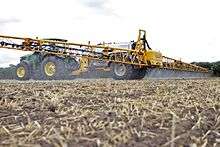Preemergent herbicide
Preemergent herbicides prevent the germination of seeds by inhibiting a key enzyme. In some areas of the world, they are used to prevent crabgrass from appearing in lawns.[1] Preemergent herbicides are applied to lawns in the spring and fall, to prevent the germination of weed seeds. They will not affect any established plant. In the spring, they should be applied when air temperatures reach 65–70°F for four consecutive days. In the fall, they should be applied when nighttime lows reach 55–60°F for four consecutive nights.[2]

"Weed and feed" products which contain both preemergent herbicide and fertilizer in a single product should not be used on southern lawns or warm-season grasses. If applied when preemergent herbicide is needed, the fertilizer may burn or stress the lawn. If applied after the lawn "green-up", weed seeds will have already germinated and the herbicide will be ineffective.[3] Preemergants do not prevent seeds from germinating, they prevent cell division, and prevent vital parts of the weed from forming
Brands
| Brand | Ingredient | Prevents | Notes |
|---|---|---|---|
| Barricade | prodiamine | crabgrass | [4] |
| Dimension | dithiopyr | crabgrass | [4] |
| Dimension 750 | dimethyl tetrachloroterephthalate | ||
| Pendulum | pendimethalin | crabgrass | |
| Pestanal | dimethyl tetrachloroterephthalate | ||
| Surflan | oryzalin | crabgrass | |
| Tupersan | siduron | crabgrass |
Crabgrass
To prevent growth of crabgrass, preemergent herbicides must be applied at a critical time. If they are applied to the soil too early, they get washed too deep into the soil or washed away by rainwater. If they are applied too late, the key enzyme inhibited is no longer active. The best control requires a second application about 6–8 weeks later. This provides coverage in mid-late summer when crabgrass can still germinate. Depending on location, one rule of thumb is to apply when the local forsythia blooms are wilting. In the northeast, they need to be applied before azaleas bloom.
References
- Wright, Robert (April 20, 2010). "The Dandelion King". New York Times. Retrieved 2010-04-21.
'Pre-emergent' herbicides are laid down more than once in the spring (mixed in with the fertilizer) to sabotage the germination of crabgrass, dandelions and other undesirables.
- Williamson, Joey. "Managing Weeds in Warm-Season Lawns".
- Tyson, Jenion. "When to apply preemergent herbicides".
- "Time is right to prevent crabgrass from sprouting". Osawatomie Graphic. April 7, 2010. Retrieved 2010-04-21.
Most of the products that prevent crabgrass contain Dimension (chemical name — dithiopyr) or Barricade (chemical name — prodiamine). Both of these chemicals work well and are long-lasting, so they stop crabgrass throughout the summer.